Cooler temperatures are the thing again with a slight freeze in Ohio. I tend to feel drained when the days are rainy but that sunshine sure makes one feel good again! We turned the garden over this week and that's the last of the tomatoes until next year. I do really enjoy the garden and the benefits of enjoying the fresh vegetables all winter long but it keeps one busy during the month of August. Now its apple time....I like making the fresh applesauce and putting away a few whole apples for the apple crisp and pies. There's nothing better than a warm apple crisp on a cold winter day.
Let's face it....there isn't much to do with the pond now that summer is ending and things are put to bed. I pulled all the water hyacinths out last week. Trimmed up the lilies and took all the tropical waterlilies and put them to bed in the greenhouse for the winter. I still have to drop the hardy waterlilies but some are still blooming so I'll wait awhile yet. My cardinal flower is still standing tall and I must say this has been its best year yet! I had at least 7 flowers on it and the hummingbirds sure were happy!!
I'm not certain of the identity of this butterfly. I thought perhaps it was a male Eastern Tiger Swallowtail. I'm really not certain, although it sure liked my dwarf crab-apple tree. It came back day after day.....I'm thinking it was the same one.
I know we don't want to think about it but it won't be long and fall will be here and we all know what comes next.....its time for us to be thinking about taking the extra care with our pond plants to make them comfortable for the winter cold. I've noticed the butterflies aren't as plentiful as they had been but occassionally I'm able to catch one.
HARDY BOG/MARGINAL PLANTS
Once your hardy marginal plants begin to brown, usually after the first hard frost, prune back excess foliage and discard any decaying material, so it does not compromise the water quality over the winter months. Potted bog plants such as Pickeral, Thalia Dealbata, and Japanese Variegated Iris should be placed at a sufficient depth to avoid freezing the crown of the plant. Most of the other hardy bog plants can be left as they are and will return the following spring.
Tropical Bog Plants
Many of the tropical bog plants will winter well indoors in a sunny window or with a grow light. They do not need to be submerged in water. Keep the soil constantly moist by placing the potted plants in a tray of water.
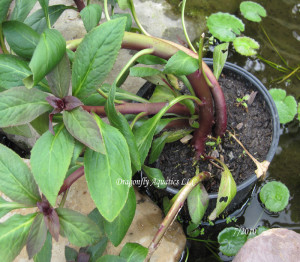 This is the Cardinal Flower I brought home from the greenhouse this spring and wondered at the time if it would straighten up. The Cardinal Flowers were all nice plants this year but some were growing slanted in their containers. The one I had planted a couple years ago didn't survive. Now I know we say "Don't Drown those bog plants" so I should know better. But too much water did it in, so I tried another. This year I'm glad to report it bloomed and flourished. It didn't straighten up until it started to bloom. I transplanted it after several weeks from its pot directly into my bog area and hoped that it wasn't too late to prevent it from blooming. I had wanted to give it some time to adjust to the water depth before I planted it directly in the pond but then I just got too busy to plant it. Look how gorgeous the flowers are. I think its a winner!
This is the Cardinal Flower I brought home from the greenhouse this spring and wondered at the time if it would straighten up. The Cardinal Flowers were all nice plants this year but some were growing slanted in their containers. The one I had planted a couple years ago didn't survive. Now I know we say "Don't Drown those bog plants" so I should know better. But too much water did it in, so I tried another. This year I'm glad to report it bloomed and flourished. It didn't straighten up until it started to bloom. I transplanted it after several weeks from its pot directly into my bog area and hoped that it wasn't too late to prevent it from blooming. I had wanted to give it some time to adjust to the water depth before I planted it directly in the pond but then I just got too busy to plant it. Look how gorgeous the flowers are. I think its a winner!
Not only did it get one flower but I have several more getting ready to bloom. Now that its established it will spread to even a healthlier plant by next year. At least that's my hope.
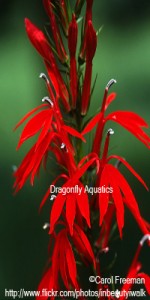 I thought I'd publish this article we wrote last year again. When trying to get some of the bog plants started in your ponds its best to start them out slowly in the water, since most of them are swamp like plants. They can tolerate a few inches above their pot once they are established and growing. When growing them in our greenhouses we have them growing in two inch net pots in bins that have about one inch of water in them so the water is keeping their roots wet.
I thought I'd publish this article we wrote last year again. When trying to get some of the bog plants started in your ponds its best to start them out slowly in the water, since most of them are swamp like plants. They can tolerate a few inches above their pot once they are established and growing. When growing them in our greenhouses we have them growing in two inch net pots in bins that have about one inch of water in them so the water is keeping their roots wet.
Here's the article.
I've been wanting to write something on this subject for some time now. Finally, I have a bit of time to address the subject of water depth for bog plants and marginal plants. Simply put, bog plants like their "feet" wet. Translation....roots and soil moist at all times. When the plants are first planted, this is especially important. Many of the bog plants will take deeper water as they mature and spread. But, when you first receive your bog plants, you will have better success if you place them where there is no more than a half inch or less of water above the soil line. Think of the marshes and swampy areas, you have passed while traveling down the road. These natural reservoirs, fill during the rainy season and will dry out during dry spells. The plants adjust to the varying water depth and grow and spread rapidly. If you have a question on a particular plant, just ask and we will be happy to help you plant and grow beautiful marginal and bog plants.
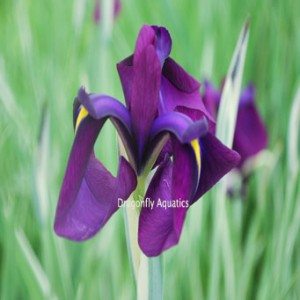 Once your hardy marginal plants begin to brown, usually after the first hard frost, prune back excess foliage and discard any decaying material, so it does not compromise the water quality over the winter months. Potted bog plants such as Pickerel, Thalia Dealbata, and Japanese Variegated Iris should be placed at a sufficient depth to avoid freezing the crown of the plant. Most of the other hardy bog plants can be left as they are and will return the following spring.
Once your hardy marginal plants begin to brown, usually after the first hard frost, prune back excess foliage and discard any decaying material, so it does not compromise the water quality over the winter months. Potted bog plants such as Pickerel, Thalia Dealbata, and Japanese Variegated Iris should be placed at a sufficient depth to avoid freezing the crown of the plant. Most of the other hardy bog plants can be left as they are and will return the following spring.
Picture of customer's pond. Thank you for sharing. The plants shown were purchased from Dragonfly Aquatics. Some of the plants shown are Water Hyacinths, Four Leaf Clover, Water Celery, Cardinal Flower, Water Lettuce and Denver Water Lily in this picture.
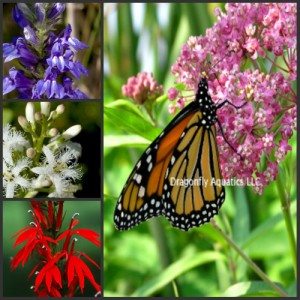 I've been wanting to write something on this subject for some time now. Finally, I have a bit of time to address the subject of water depth for bog plants and marginal plants. Simply put, bog plants like their "feet" wet. Translation....roots and soil moist at all times. When the plants are first planted, this is especially important. Many of the bog plants will take deeper water as they mature and spread. But, when you first receive your bog plants, you will have better success if you place them where there is no more than a half inch or less of water above the soil line. Think of the marshes and swampy areas, you have passed while traveling down the road. These natural reservoirs, fill during the rainy season and will dry out during dry spells. The plants adjust to the varying water depth and grow and spread rapidly. If you have a question on a particular plant, just ask and we will be happy to help you plant and grow beautiful marginal and bog plants.
I've been wanting to write something on this subject for some time now. Finally, I have a bit of time to address the subject of water depth for bog plants and marginal plants. Simply put, bog plants like their "feet" wet. Translation....roots and soil moist at all times. When the plants are first planted, this is especially important. Many of the bog plants will take deeper water as they mature and spread. But, when you first receive your bog plants, you will have better success if you place them where there is no more than a half inch or less of water above the soil line. Think of the marshes and swampy areas, you have passed while traveling down the road. These natural reservoirs, fill during the rainy season and will dry out during dry spells. The plants adjust to the varying water depth and grow and spread rapidly. If you have a question on a particular plant, just ask and we will be happy to help you plant and grow beautiful marginal and bog plants.
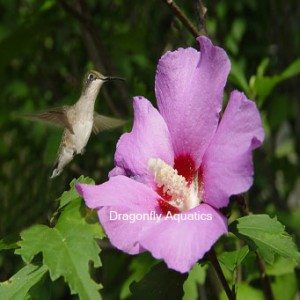 Hummingbirds are primarily attracted to bright colors such as, red, orange and dark purple colors. Tubular shaped flowers are among their favorites because of the amount of nectar they can hold. While flower clusters also attract them, they don't hold as much nectar and the hummingbird has to make more trips expending more energy to consume enough nectar. They also feed on small spiders and tiny insects found amongst your flowers.
Hummingbirds are primarily attracted to bright colors such as, red, orange and dark purple colors. Tubular shaped flowers are among their favorites because of the amount of nectar they can hold. While flower clusters also attract them, they don't hold as much nectar and the hummingbird has to make more trips expending more energy to consume enough nectar. They also feed on small spiders and tiny insects found amongst your flowers.
You may want to plant smaller trees around your pond to give them a place to perch. They like the smaller branches, twigs or leaf stems to sit on and rest. The trees that attract them are your lilacs, rose of Sharon, hawthorn, redbud and weigela.
Among the pond plants that they seemed attracted to the most are the butterfly plant, hibiscus, lobelia, obedient flower and cardinal flower. If you have an area around your water garden to plant other ground plants this will also attract them to your pond. Such plants as foxglove, mandevillas, petunias, hollyhock, columbine and lupine are a few favorites of the hummingbird. I found by planting impatiens and hibiscus in my bog area creates a nice look and gives the hummingbirds a place to enjoy.
Not only will you be attracting hummingbirds to your pond area but butterflies enjoy alot of the same plants. Where your hummingbirds are attracted to the nectar by sight, the butterflies are attracted to them by the smell.
Enjoy every aspect of nature by creating that area where you'll not only enjoy the peacefulness of your water garden but the magnificent hummingbirds as well.
Buy obedient flower,cardinal flower,lobelia here.
 Cardinal flowers are known for their intense bright red flowers, which bloom July through October. Cardinal flowers grow best in sun to part shade. Plant it in moist soil or water no more than 3 inches deep. It will spread to about 12 inches. Hardy in Zones 5-11 but will be fine to Zone 3 with snow coverage. A hardy bog plant that will come back each year. It has single stems that can reach up to 3 feet in height with leaves that grow out and up from the stems until the flower spike appears.
Cardinal flowers are known for their intense bright red flowers, which bloom July through October. Cardinal flowers grow best in sun to part shade. Plant it in moist soil or water no more than 3 inches deep. It will spread to about 12 inches. Hardy in Zones 5-11 but will be fine to Zone 3 with snow coverage. A hardy bog plant that will come back each year. It has single stems that can reach up to 3 feet in height with leaves that grow out and up from the stems until the flower spike appears.
This is a popular plant for all water gardens. Whether you place it in shallow water or along the edges of your pond you will enjoy the intense red flowers when they appear. It attracts a lot of hummingbirds, dragonflies and butterflies. A nature loving plant. I consider this a must have in my water garden and look forward to it blooming each year.
Buy cardinal flowers,lobelia cardinalis,hardy bog plant here.